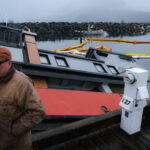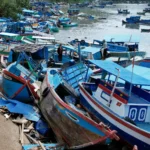Pavlof

On the morning of December 4, the 27 meter long fishing vessel Pavlof (MMSI: 338132058) sank in the Chilkat Inlet within the harbor of Haines, Alaska. Harbor authorities were alerted finding the Pavlof resting on the bottom on its port hull. Booms were placed around the partially sunk hull to help contain some of the 1300 gallons of diesel fuel onboard. Staff would continued to help secure the vessel as it disconnected the electrical and connections to free the vessel. Work continued well into the evening with divers attaching lines to the hull and connecting the fishing vessel to a barge.
On the following morning, the Pavlof’s was secured and partially refloated and was upright. Three of the 4 fuel vents were closed and the remaining fuel can be pumped off the vessel. Initial reports suggest that snow may have been the cause of the sinking. No reports of injuries.



























